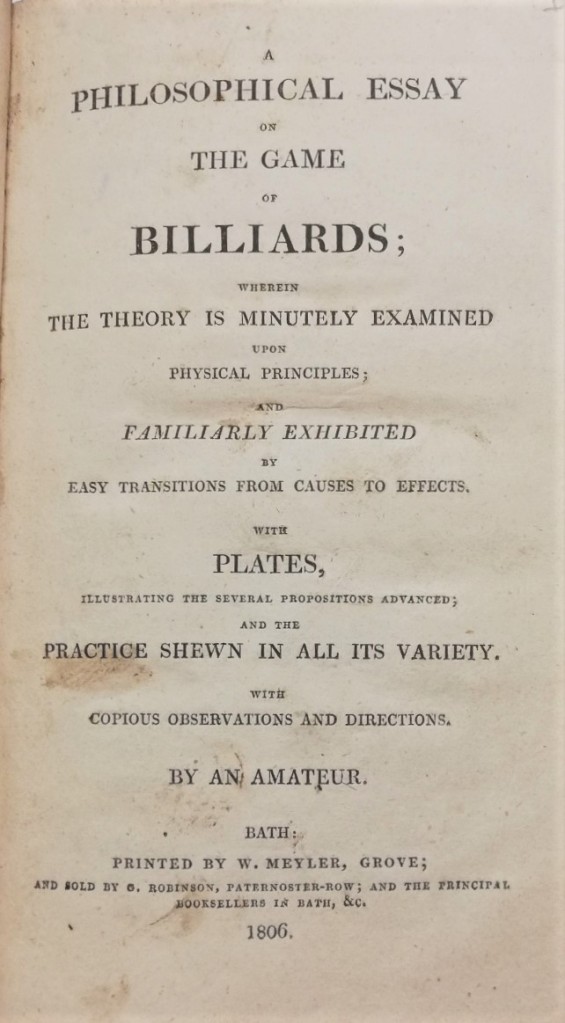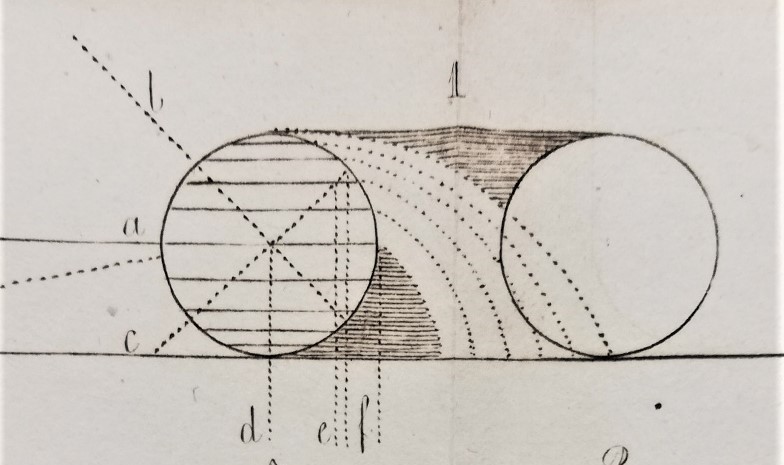Susan Durack, Special Collections and Archives

On a recent browse through the Pamphlet Collection held in the Russell Library at Maynooth University I came across a curious and somewhat long title.
“A philosophical essay on the game of billiards: wherein the theory is minutely examined upon physical principles; and familiarly exhibited by easy transitions from causes to effects: With plates illustrating the several propositions advanced and the practice shewn in all its variety with copious observations and directions”.
Who would write such a pamphlet? We are none the wiser, as the author signs himself “An Amateur” on the title page and ends the essay as “Philobill”. Printed in Bath by W. Meyer and sold by G. Robinson, of the same city in 1806, the fifty-nine page pamphlet is followed by a four-page appendix and two fold out diagrammatic sheets, which are referenced throughout the main text.
One can only imagine the difficulty in describing the intricacies of the game, in an interesting way, without the benefit of modern technology and commentary that we enjoy today. Such was the problem for Philobill in 1860. He does not make it easy for the reader and in fact describes whom this essay will not benefit…
“The perusal of the following pages will not be of any use to a good player” as practice and experience are indispensable. Neither does he suggest that the novice will derive much advantage from it as a course of instruction, as liking the activity, tops reading technical instruction. But he says, it may be useful to those “inquisitive travellers” who when encouraged to play, “may be better accommodated on the road to Science” in linking cause and effect and Nature’s Laws and therefore the essay “cannot be charged as useless”.
The scientific and verbose language of the text is accompanied by two fold out diagramatic sheets that are intended to help our understanding, but as you will see from the text below, it takes some effort on the part of the reader.
“The progressive motion takes place with the middle point at both ends of the cue, and the centre of the ball make part of a right line at the time of impulse; and if this position be also parallel with the table, as a, (see Fig1) it will be smoothest, lightest, and the least impeded. For such the cue be pointed downwards, as in b, the motion of the ball mush be partly destroyed by the reaction of the table; and, if pointedopwards, as in c, or anywhere else, the power of gravity would be more directly in opposition to it….”

He notes that Chance is the “common enemy of bad players” but the writer does not wish to have it taken from the game but to confine it “within due and reasonable bounds”. While games of judgement are sources of amusement and may be down to expertise and skill, the writer warns “those merely of chance” never can and man’s exalted nature becomes inactive and he falls for the “favours of that capricious deity who presides”.
There were two contrasting reviews of the essay in periodicals of the day. John Richards Green (1758-1818) in The Anti-Jacobin Review and Protestant Advocate: Or, monthly political and literary Censor (Vol. 26, 1806) stated, “This is not merely a curious and ingenious, but a truly scientific essay of the Game” and “we conclude that the author be not only an amateur but a connoisseur. While the essay “will not be a pleasing study to novices or to players, who have made certain progress in the knowledge of the Game but it affords both amusement and instruction”.
Tobias Smollett (1721-1771) editor of The Critical Review: Or, Annals of Literature (Vol. 10, 1807) states that the author “has better claim which he gives himself at the end of his treatise (Philobill) than that of philosopher to which he seems to aspire in his title page”. The review questions who this essay is for, if not the experienced player or novice. It goes on “a more flimsy performance we have rarely seen” and that the author should “take his cue, and give up authorship”
Both critics agree in their observations on the author’s assertion as to who would not benefit from this essay.
Some facts about Billiards: Billiards evolved from a lawn game similar to Croquet, played in the 15th century in Northern Europe, probably France. Kings and commoners played it alike. The term billiard is derived from the French word “billart” meaning wooden stick or “bille” meaning ball. The first Billiard Room was built in England in 1785, which was a table with one pocket and four balls. Billiards was the inspiration of the development of snooker and other pool games played today.
For more on the history of billiards, click here.
